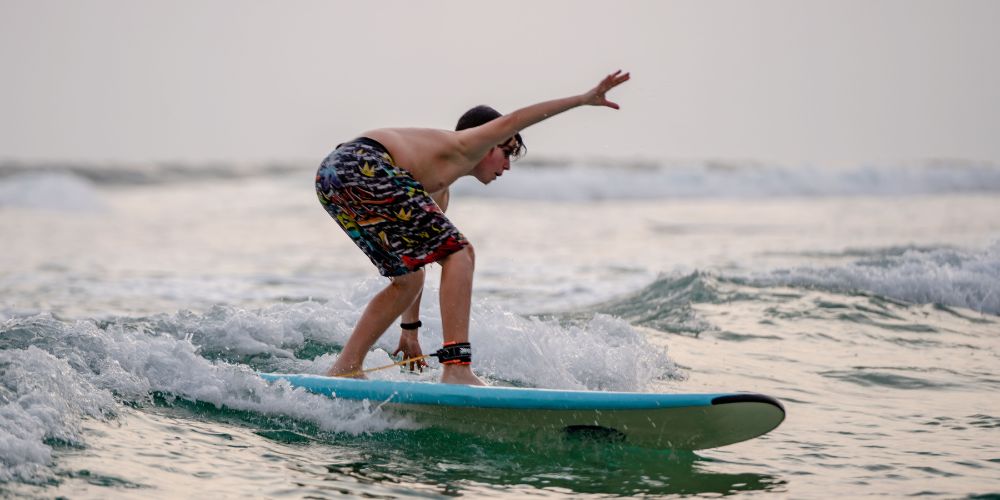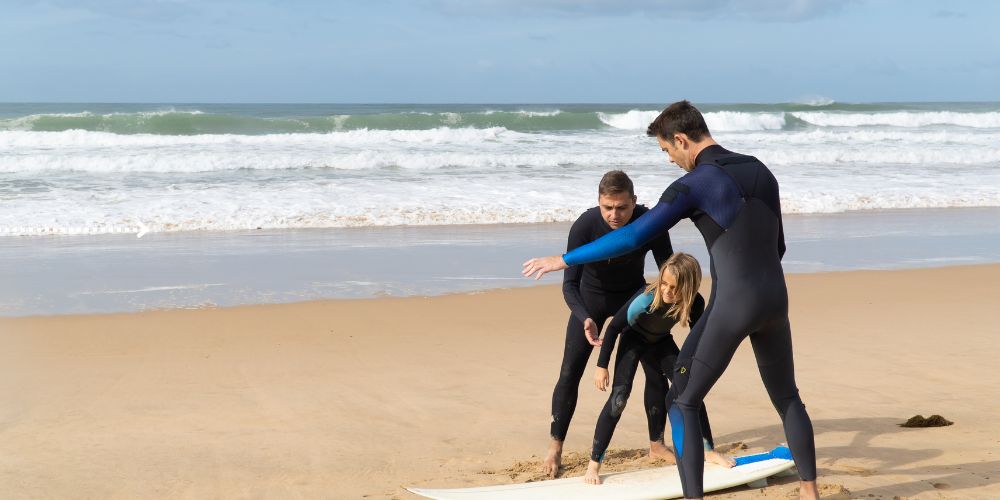Imagine yourself surrounded by the ocean, heart pumping as you ride and carve through the waves with a surfboard under your feet – it’s truly unforgettable. If you ever ask any veteran surfer, they’ll tell you how refreshing and freeing it is – it connects you with nature. And well, it’s also a great workout if you have missed a few days of the gym.
If you’re new to the sport, don’t worry – learning to surf takes time and practice, but if you get a few things straight, you’ll be an expert in no time. In this surfing guide for beginners, we’ll cover gear, spotting good waves, safety tips, and simple steps to catch your first surfing waves.
Surfing Equipment for Beginners: What You Need to Get Started
When you head out to surf, bring the right surfing equipment for beginners:
- Soft-top longboard: Choose a foam longboard about 8–9 feet long for extra stability. These boards float well and help you balance easily. The board should have fins on the bottom to help it hold a straight line on the wave.
- Leg Rope (Leash): Take the attached surfboard leash and put it around your ankle. This cord keeps the board from drifting away when you fall, so you won’t have to swim after it. A leash is considered one of the most essential beginner surfing items.
- Wetsuit or rash guard: A wetsuit (for cold water) or rash guard (for warm water) protects your skin from the sun, cold, and board scrapes. It also keeps you a bit warmer and prevents “board rash.”
- Wax: There is a surf wax that you must apply a coat of to the top of your surfing board. Wax gives grip so your feet won’t slip off the board while paddling or standing.
Best Surf Spots for Beginners: How to Choose the Right Waves
For your first waves, look for a sandy beach with gentle, slow waves. Beginners do best in 1–3 foot waves that break softly on sand. Avoid spots with sharp coral, rocks, or shallow reefs, especially at low tide, since these can cause injury. Ideally, you should choose a gently sloping beach where the shoreline allows small, slow-moving waves to roll in without breaking forcefully.
If a wave looks too big or fast, skip it – true big wave surfing (8+ foot waves) is only for advanced surfers. Also avoid crowded breaks where many surfers line up, and stay a safe distance from other people in the water. When in doubt, ask a local surf shop or instructor for a friendly beginner spot. They can recommend mellow beaches and small breaks that are safe to learn surfing.
Surfing Safety Tips for Beginners: Stay Safe and Surf Smart

Safety comes first – it helps you feel confident and have fun. Check the weather and ocean conditions – and always know your limits. Before paddling out, check the weather, tides, and currents. A surf instructor will do this and only choose waves suitable for your level. Stay in waist-deep water at first and don’t go beyond where you can comfortably stand.
Always remember, you’re not alone in the water – surfing is a shared experience. We strongly advise that you always keep a safe distance from other surfers, follow right-of-way rules, and don’t drop in on someone else’s wave. It’s also important to surf with a friend or surfing trainer. A surf school advises that beginners should never surf alone – having a buddy nearby means help is there if you wipe out or get caught in a rip current.
Expert tip: Waves between 5–8 feet are for experienced surfers, and anything over 8 feet is best left to the pros.
Pop-Up Practice for Beginners: Master Your Surf Stance on Land
Build muscle memory before hitting the water by practicing the pop-up on dry land. Lie flat on your board (or on the sand) with your hands flat on the deck beneath your chest. In one smooth move, push up with your arms (like a fast push-up) and quickly slide your feet forward under you – bring your front foot up near your hands, then the back foot up under your hips. End in a low crouch with knees bent, eyes forward, and feet shoulder-width apart.
Try this sequence over and over until it feels natural. You can even do it on grass or a yoga mat – the goal is to turn your surfboard pop-up into an automatic motion. Practicing on land helps your muscles remember the steps, so you can focus on the wave when you’re actually in the water.
What to Expect During Your First Surf Session

When you finally paddle out, remember that falling off your board is normal for beginners. As one instructor points out, you’ll “fall off your board a lot” at first before getting the hang of timing. Don’t be discouraged by wipeouts – every surfer started this way. Begin by catching whitewater waves (broken waves that have already spilled) close to shore.
These are smaller and push you gently, making it easier to practice your pop-up. Keep your first sessions short – maybe 15–20 minutes – and rest often so you don’t get too tired. Take a break on the beach if you feel fatigued or uneasy. By focusing on the basics in safe conditions, you’ll build your comfort and confidence. Each time in the water, celebrate small progress – even sitting up on the board or catching a tiny wave is a win.
Beginner Tips for Catching Your First Wave

Here are some surfing beginner tips:
- Board position: Lie centered on the board so it floats evenly. Keep the nose just above the waterline (not dipping under) and look at the horizon. When a wave approaches, paddle so the board points straight into it.
- Paddling and timing: Paddle with long, strong strokes as the wave comes. As soon as you feel the wave lifting your board, give it a couple more big strokes and then pop up. Don’t rush to stand – timing is key, so only pop up once the wave has caught you and is pushing you forward.
- The pop-up: Place your hands under your chest (not on the rails of the board), push up quickly, and bring your feet under you. Land in a low crouch with knees bent, feet about shoulder-width apart, and body over the center of the board. This low, balanced stance helps you stay upright.
- Eyes and balance: Keep your eyes looking toward where you want to go – staring down at the board makes you unstable. Looking forward (down the line of the wave) naturally keeps you balanced. Spread your arms out for balance, like a tightrope walker.
- Falling safely: If you lose balance, try to fall flat into the water (not headfirst) and keep your arms over your head to protect it. Your board will float with the leash, so just swim up with it. Then paddle back to the lineup and try again. Falling is part of surfing, and each wipeout teaches you something.
Conclusion
Remember that becoming a surfer takes time and patience. Nobody learns overnight – even catching small whitewater waves is progress. Keep practicing the basics you’ve learned here: warm up, use the right equipment, start on small waves, and stay safe. Celebrate your progress, no matter how slow it seems.
And before we end this surfing beginner guide, if you are looking for a perfect “surfer’s paradise” – it’s here in the Mentawai Islands. Situated in Indonesia, they are legendary for surfing – just search “surfing indonesia.” This chain of islands offers warm water and consistent waves almost year-round, making it one of the world’s top surf destinations. A great place to stay in the Mentawai Islands is Bela Sulu Villas, located in South Sipora. It’s a quiet retreat near Katiet Beach – just a short walk from one of Indonesia’s best surf breaks. Bela Sulu promises comfortable, luxurious villas and stunning ocean views, so you can relax in style after a day of surfing.
Also read: Surfing and Life: Transformative Lessons from the Waves



